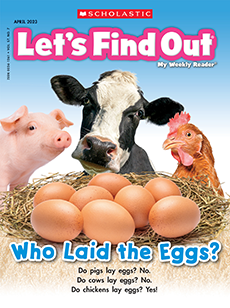A guide for using our resources
Children will distinguish between pushes and pulls.
Vocabulary: fempujar, fuerza, halar
Science Focus: force and motion
Simple, spectacular ideas to boost your lessons.
Paired Text: ¡Mira cómo lanzo la pelota! by Mo Willems
Paired Text: ¡Mira cómo lanzo la pelota! by Mo Willems
- Elefante thinks that you need a lot of skill to throw a ball. Cerdita thinks it's all about having fun.
- Ask children, ¿Con quién están de acuerdo? There are no wrong answers.
Science observations: ¿Halar o empujar?
Science observations: ¿Halar o empujar?
- Gather toys like a wagon, a car, a yo-yo, blocks, or any other toy that children can move by pushing, pulling or both.
- Ask students to push or pull the items and, once they fi gure out how the toys work, have them write or draw their answers in the ¿Halar o empujar? skill sheet.
Scavenger Hunt: Encuentra la h muda
Scavenger Hunt: Encuentra la h muda
- Some people say jalar, others say halar. It's OK, both are correct! We used halar so that children can practice reading the h in Spanish. It doesn't have a sound! ¡Es muda!
- Ask children to find all the h letters across the issue.
- Then think of other words in Spanish that start with h, like huevo, hacha, and so on.
Prueba a halar y empujar
Prueba a halar y empujar
Skill: testing and recording
Materials: Prueba a halar y empujar skill sheet, box with handles (or any box plus a sturdy trash bag with handles), books, classroom chairs
- Prepare this simple experiment by filling a box with books. Use a box with handles or, if that’s unavailable, put the books in any box and then put the box in a trash bag with handles. Place the heavy box and a light classroom chair at a starting line. Use masking tape to mark a finish line a few feet away.
- Let kids take turns pushing the box to the fi nish line. Next they can pull the box. Which worked better? Have them record their answers on the skill sheet.
- Now each group can do the same test with the chair— push it, then pull it. Which was better?
- Last, children can see which goes farther with a big push—the box or the chair. Which was easier to move? Which was heavier?
